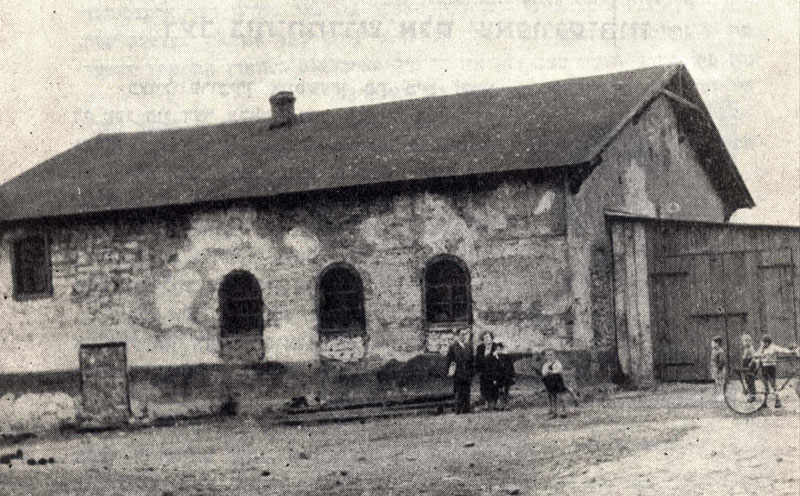Wolbrom Before the Holocaust
Religious Life
The Synagogue
"Things were different when it came to the synagogue. Although both the synagogue and the Beit Midrash were close, the distance between them was powerful. The great synagogue stood in the dark, full of secrets, frightening in its appearance. Various legends were spun around the synagogue. It was said that every night after midnight the dead came into the synagogue to pray; that those who could not find rest came searching for their "tikkun” (mending); that the dead would take the Holy Scriptures from the Ark and read the Torah. Therefore, whoever went by the synagogue at night was to knock on the gate three times to make the dead disappear…..Young children, and perhaps also the older ones, were afraid to walk past the synagogue at night. The result of these legends was that no mezuzah was placed on the synagogue’s door. Still today I remember the fear that the synagogue threw upon me when I went home late at night….”
Moshe Lubling in Wolbrom Irenu (Our Town Wolbrom).
The Beit Midrash (Study Hall)
“…When one wants to browse through the history of the town, one must begin with the Synagogue and Beit Midrash (Study Hall), not as an integral part of the town, rather as a treasury of the souls of the people. From the Beit Midrash we inherited all religious and ethical values that had in the course of years fortified the existence of the Jewish people and strengthened its ability to survive. This is true from a historically religious point of view, as well as the sociological standpoint. The influence of the Beit Midrash cannot be regarded lightly. I am thinking of the simple people between Minchah and Maariv (the afternoon and evening prayers), of the fact that in the Beit Midrash Jews discovered the news of the town and news of the world, and everyone was able to speak out his opinions about town matters, as well as discuss important world problems. Here they spoke of wars, determined who should be victorious and who should lose; here the people sitting in the backbenches were able to destroy entire armies. They would go on during the long winter nights, between the two "koplove" ovens that spread a pleasant warmth…
I do not pretend to provide a comprehensive description of the Beit Midrash…I want only to mention the times I spent learning during my younger years. Tables with benches stood on three sides of the room. Students of different ages sat around them, studying with enthusiasm. Each learned with his particular song, each with his unique accent, and all the voices merged into one great symphony.
Learning lasted from before sunset until late into the night, and this went on for dozens, perhaps hundreds, of years...And merchants, after they closed their shops, and artisans, having finished their work, used to come to pray Maariv, and they would stay afterwards to partake in learning…. the Beit Midrash was a source that nourished the lives not only of the students, but also of the simple Jews. Whenever there was trouble, the Jew ran to the Beit Midrash. Here he forgot all his worries; here he could pace the floor with his hands behind his back undisturbed; here he could listen to gossip about other town Jews, discuss town matters, such as the election of a new Rabbi, or engaging a Shohet or a Cantor... Many Jews came to the Beit Midrash because their houses were cold-they had no wood for heating, and their personal problems drove them from their homes.
They would come to the Beit Midrash to warm themselves by the oven, and to listen to the wonderful tales that were told there - tales about good Jews who suffered for many years, and about the Prophet Elijah bringing them good luck. They listened to common stories about demons and spirits that wandered around every night after midnight by the walls, looking for ways to harm people. The simple people were happy to be in the Beit Midrash, where the demons were powerless.
…The Beit Midrash provided comfort to the weak. It was a children's home for children, a school for youngsters, and a university for the adults. Yet later, when political parties were coming into being, all the leaders came from among the students of the Beit Midrash. Zionism was the bridge leading the youth from the Beit Midrash to social and political life...”
Moshe Lubling in Wolbrom Irenu (Our Town Wolbrom).
Hassidism
“Hasidism was present in Wolbrom from the movement’s very inception in Poland. The town’s followers of Hasidism were not concerned by the threats of the “Misnagdim” (opposition), who were present everywhere. There was a concentration of Hasidim and other committed people in Wolbrom who were bound together by a strong faith, steadfast morality and deep-rooted Hasidism… most of them were laborers and workers - a kind of "Hasidic proletarian".
The early Wolbrom Rabbis were apparently closely associated with the Krakow community. One of the Wolbrom Rabbis, Menachem Nachum Binyamin, asked to be buried in Krakow.




